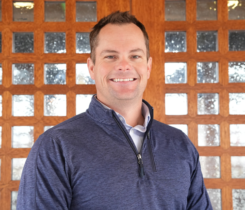Off the Record: A history of golfer footwear

Mike Kenna
Do you remember the sound of metal spikes? The earliest evidence of a shoe with spikes (hobnails) is from an 1893 photo of players in New Zealand. Walter Hagen wore hobnail shoes for his U.S. Open victory in 1914. Bob Jones wore them in the 1916 U.S. Amateur, and golf shoes with spikes were regular footwear by 1919.
In 1948, the USGA Green Section’s Fred Grau, Ph.D., and Marvin Ferguson, Ph.D., addressed a different problem. Golf courses were not allowing the use of shoes with rubber lug soles. Grau and Ferguson compared shoes with lug soles to those with steel spikes. In their limited study, they concluded that shoes with lug soles caused less damage than those with metal spikes.
Marvin Ferguson continued to study the problem at Texas A&M University in 1958. This experiment had golf shoes with metal spikes, rubber cleats and a rippled sole. There was a gradual decline of putting green turf for all the designs. But, metal spikes and cleats caused more rapid damage to the turfgrass than the rippled soles.
By 1963, golf’s popularity was growing and so was the amount of traffic on courses around the country. Bill Bengeyfield, USGA Green Section, suggested rounds of golf would outpace new golf course construction. He warned that traffic would become a significant problem for golf course superintendents.
The USGA recommended recessed spikes in the 1970s, and some progress occurred when shoe companies provided spikes without shoulders. By the 1980s, a dramatic change in shoe design took place. New, rubber, multistud soles started to circulate in the golf community. Golf course superintendents claimed they caused more damage. The time was right for the “Green Section Golf Shoe Study II.”
In early 1983, Bengeyfield, along with Vic Gibeault, Ph.D., and Vic Youngner, Ph.D., conducted the golf shoe study. Four shoe designs included metal spikes, two popular multistud designs and spikeless soles. Under all the conditions tested, metal spikes caused the most damage. The two studded shoes were the second most damaging, and the spikeless shoes caused the least amount of damage. The high surface contact area of 750 small rubber cleats was the best.
The Green Section Record had the results of the golf shoe study in the September/October 1983 issue. With the ink barely dry, Larry Gilhuly started his 36-year career with the Green Section in November 1983.
By 1992, Gilhuly opined the article “Search Your Sole — Remove Your Spikes!” He asked, “What have we learned from not one, not two, but three excellent studies concerning the negative effects of golf shoe spikes? Apparently, very little!” Nothing had changed as far as golfers’ dependency on metal spikes. The consequences were millions of dollars of damage to greens.
Gilhuly asked golfers to do a little “sole searching.” He hoped someday spike mark controversies would be a thing of the past. A change in momentum started with Gilhuly and his visits to Warm Springs Golf Course in Boise, Idaho.
Winter damage concerned General Manager Ernie Deacon and Superintendent Lee Monroe. They banned metal spikes during winter play but provided a “soft spike” alternative for conventional golf shoes invented by Faris McMullin. They thought golfers would appreciate better greens. Wrong!
Gilhuly did not give up and practiced what he preached. He then penned, “The Metallic Mashers of Monocots: Golf Spikes!” in the September/October 1996 issue of the Green Section Record.
He also convinced Green Section staff to try spikeless alternatives. Spikeless training shoes and soft spikes worked great. More importantly, we all observed the improvement in putting greens at golf courses going spikeless. Golf went from a humble half-million pairs of spikeless alternatives in 1993 to 20 million in 1995 to who knows how many today.
Golfers can pat themselves on the back; they are helping provide better putting greens. The carpets in the pro shop and locker rooms also look better now. Greens would be even better if golfers would fix their ball marks too!













It’s funny. I “really” started playing golf in 1991 in Boise, Idaho (primarily at the Warm Springs Golf Course in Boise). Of course I wore a pair of metal spiked golf shoes at the time. Several years later I found out that the inventor of the metal spike-less golf cleat had been patented in Boise. Even at the time I played at Warm Spring I had no idea that the inventor was connected with this plastic golf spike. I think this would be a good article or story.